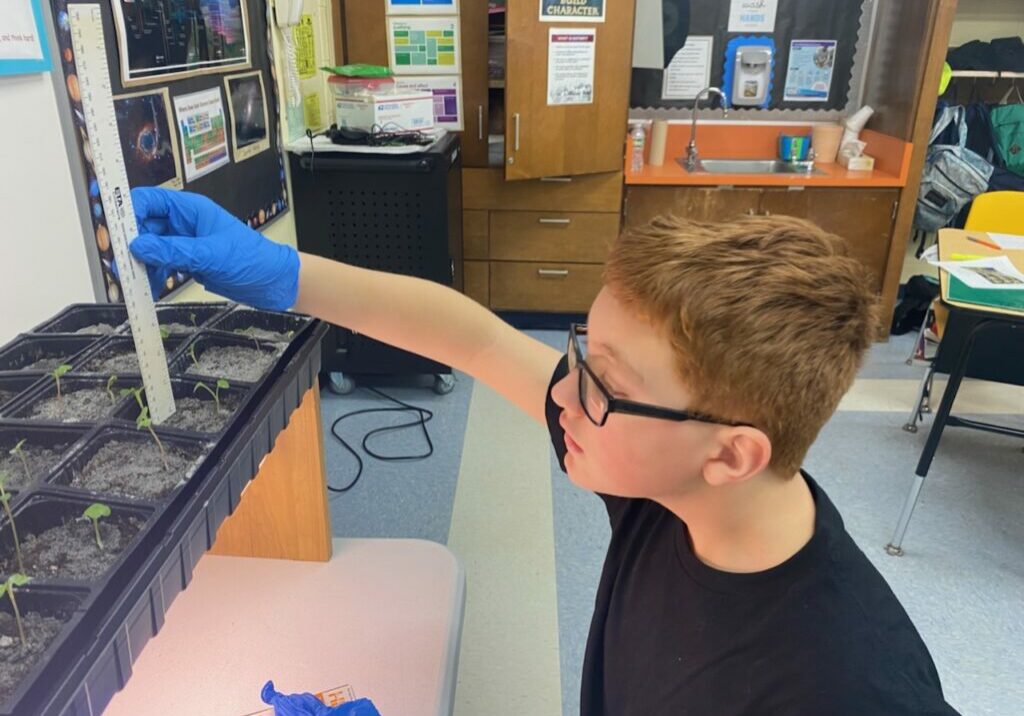In May, Frederic A. Priff Elementary School students, guided by teacher Brent Cunningham, won an award for the Best Crop Growth in the Elementary School division of the competition in the Plant the Moon competition, sponsored by organizations such as the Institute of Competition Sciences, NASA SSERVI and the Space Grant Consortium.
Cunningham described the work that he is doing with his fifth- and sixth-grade students:
“During the course of the year, we focused heavily on planetary science, the development of life on the early Earth, and the needs of living things. During the winter, I found a competitive science program called Plant the Moon through the Institute of Competition Sciences. This program sought to challenge elementary students and above with the task of growing viable crops in lunar or Martian regolith simulant. The program also collaborates with NASA’s Solar System Exploration Research Virtual Institute (SSERVI) and is supported by the NASA Space Grant Consortium and the Mosser Lee Company (through Soil Master). It contained over 700 teams from five different nations.
“The students were very excited about the project upon hearing about it and we quickly went to work voting on whether we would plant in lunar regolith simulant or Martian regolith simulant. The class opted for lunar soil, and we then had to research and determine which crops would be attempted.
“After much discussion and voting, we landed on Cherry Belle Radishes since they are able to grow in slightly acidic soil, can tolerate lower temperatures, and have a rapid harvest time (22 days). The next task was to determine our hypothesis/guiding question. The class determined that the soil needed for plant growth would likely have to require some sort of biotic factors mainly contained in terrestrial soil. We realized that transporting this soil to the lunar surface would be incredibly costly, as it would add much mass to any vehicles making transport. Therefore, we chose our driving question to be about the mixture of lunar regolith and terrestrial soil and its effect on crop production. The hypothesis was that as the ratio of lunar soil to terrestrial soil increased toward a 1:1 proportion, then the plant heights and radish production would improve.
“From there we gathered the necessary materials to construct a growth space in the classroom that would be affected by the least amount of uncontrollable variables (not near the window, not near the HVAC vents, etc.). The students established variables (independent and dependent) and controls for the experiment. The independent variable was the mixture of lunar regolith and terrestrial seed-starter mix. The dependent variables were radish growth and development, plant height, and leaf width. The process controlled aspects such as lighting, temperature, humidity, and watering.
“The mixtures of soil were:
- 100% lunar soil
- 90% lunar soil / 10% terrestrial soil
- 80% lunar soil / 20% terrestrial soil
- 70% lunar soil / 30% terrestrial soil
- 60% lunar soil / 40% terrestrial soil
- 50% lunar soil / 50% terrestrial soil
- Control pots contained 100% terrestrial soil
“As a secondary experiment, we also had lima bean seeds that had flown aboard a NASA sounding rocket during a previous year with a club that takes part in a program called Cubes in Space. Since these seeds had already been exposed to high amounts of cosmic radiation, as they would during flight to the moon, we thought this would be a great secondary experiment. For this experiment, we maintained the same variables and controls, except the mixtures were different (100% lunar soil, 75% lunar/25% terrestrial, and 50% lunar/50% terrestrial).
“Once the pots and growth area were established, the students donned appropriate Personal Protective Equipment (gloves) and carefully planted two seeds in each pot. From that point onward, we entered the Growth Period of eight weeks, where students took weekly measurements of the plant height, cotyledon width, leaf width (when they grew), pH values of the soil, and would regularly monitor moisture content of the soil for watering.
“At the end of the Growth Period, the students wore protective clothing again and carefully extracted the plants from the pots. They then placed them on screens and gently sprayed water to remove the soils from the plants and root structures for analysis. After this, they took their final measurements (plant height, length of hypocotyl, cotyledon width, leaf width, color of hypocotyl) and the plants were laminated on paper for preservation. Some were carefully dissected and slides were made for microscopic viewing, as well.
“Finally, the students put together their final report including measurements, graphs of the data, reflections on the experimental process, and results of the entire experiment. They did a great job with the mathematics and presentation of their findings. They really dug deep to critique the experiment on the reflection, which included future plans for not crowding the pots and creating competition for resources.
“We presented our experiment and findings at our local board of education meeting, to a fifth-grade class, and in a video and written format to the competition itself. Dr. Nancy LaFleur from Kean University also reviewed our class’s plans and added a great deal of input during our correspondence to consider for the project.
“Ultimately, our team (Lunar Landscapes) took an award in Best Crop Growth in the Elementary School division of the competition!”
Learn more about the work Cunningham is doing with Waretown’s elementary students, and how he is helping to build the next generation of scientists.











